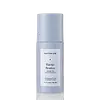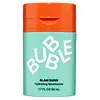What's inside
What's inside
 Key Ingredients
Key Ingredients

 Benefits
Benefits

 Concerns
Concerns

 Ingredients Side-by-side
Ingredients Side-by-side

Water
Skin ConditioningOctyldodecanol
EmollientSqualane
EmollientShea Butter Ethyl Esters
EmollientPolyglyceryl-4 Diisostearate/Polyhydroxystearate/Sebacate
EmulsifyingPropanediol
SolventC13-15 Alkane
SolventCrambe Abyssinica Seed Oil Phytosterol Esters
EmulsifyingUrea
BufferingGlycerin
HumectantSilica
AbrasivePolyglyceryl-3 Polyricinoleate
EmulsifyingSodium Chloride
MaskingSimmondsia Chinensis Seed Oil
EmollientSilybum Marianum Seed Oil
Skin ConditioningCeramide NP
Skin ConditioningCholesterol
EmollientOleic Acid
EmollientBlakeslea Trispora Mycelium Extract
Salicornia Herbacea Extract
Skin ConditioningSodium Hyaluronate
HumectantCaprylic/Capric Triglyceride
MaskingDisteardimonium Hectorite
StabilisingPhytosphingosine
Skin ConditioningHydrogenated Poly(C6-14 Olefin)
EmollientBenzotriazolyl Dodecyl P-Cresol
UV AbsorberHydrogenated Lecithin
EmulsifyingLactic Acid
BufferingButylene/Ethylene/Styrene Copolymer
Ethylene/Propylene/Styrene Copolymer
Stearic Acid
CleansingSodium Hydroxide
BufferingCitric Acid
BufferingEthylhexylglycerin
Skin ConditioningPentaerythrityl Tetra-Di-T-Butyl Hydroxyhydrocinnamate
AntioxidantSodium Sulfate
Sodium Carbonate
BufferingTocopherol
AntioxidantCaprylyl Glycol
EmollientCaprylhydroxamic Acid
1,2-Hexanediol
Skin ConditioningPhenoxyethanol
PreservativeCI 77742
Cosmetic ColorantWater, Octyldodecanol, Squalane, Shea Butter Ethyl Esters, Polyglyceryl-4 Diisostearate/Polyhydroxystearate/Sebacate, Propanediol, C13-15 Alkane, Crambe Abyssinica Seed Oil Phytosterol Esters, Urea, Glycerin, Silica, Polyglyceryl-3 Polyricinoleate, Sodium Chloride, Simmondsia Chinensis Seed Oil, Silybum Marianum Seed Oil, Ceramide NP, Cholesterol, Oleic Acid, Blakeslea Trispora Mycelium Extract, Salicornia Herbacea Extract, Sodium Hyaluronate, Caprylic/Capric Triglyceride, Disteardimonium Hectorite, Phytosphingosine, Hydrogenated Poly(C6-14 Olefin), Benzotriazolyl Dodecyl P-Cresol, Hydrogenated Lecithin, Lactic Acid, Butylene/Ethylene/Styrene Copolymer, Ethylene/Propylene/Styrene Copolymer, Stearic Acid, Sodium Hydroxide, Citric Acid, Ethylhexylglycerin, Pentaerythrityl Tetra-Di-T-Butyl Hydroxyhydrocinnamate, Sodium Sulfate, Sodium Carbonate, Tocopherol, Caprylyl Glycol, Caprylhydroxamic Acid, 1,2-Hexanediol, Phenoxyethanol, CI 77742
Water
Skin ConditioningIsononyl Isononanoate
EmollientGlycerin
HumectantHeptyl Undecylenate
EmollientGlyceryl Stearate Citrate
EmollientCaprylic/Capric Triglyceride
MaskingPolyglyceryl-3 Stearate
EmulsifyingCetyl Alcohol
EmollientAloe Barbadensis Leaf Juice Powder
Skin ConditioningAcrylates/C10-30 Alkyl Acrylate Crosspolymer
Emulsion StabilisingPersea Gratissima Oil
Skin ConditioningButyrospermum Parkii Butter
Skin ConditioningGlucose
HumectantHydrolyzed Pea Protein
EmollientSodium Chloride
MaskingSodium Succinate
BufferingOenothera Biennis Oil
EmollientHoya Lacunosa Flower Extract
Skin ConditioningAnthemis Nobilis Flower Extract
MaskingHydrogenated Lecithin
EmulsifyingArginine
MaskingTocopheryl Acetate
AntioxidantTocopherol
AntioxidantSodium Phytate
Phenoxyethanol
PreservativeWater, Isononyl Isononanoate, Glycerin, Heptyl Undecylenate, Glyceryl Stearate Citrate, Caprylic/Capric Triglyceride, Polyglyceryl-3 Stearate, Cetyl Alcohol, Aloe Barbadensis Leaf Juice Powder, Acrylates/C10-30 Alkyl Acrylate Crosspolymer, Persea Gratissima Oil, Butyrospermum Parkii Butter, Glucose, Hydrolyzed Pea Protein, Sodium Chloride, Sodium Succinate, Oenothera Biennis Oil, Hoya Lacunosa Flower Extract, Anthemis Nobilis Flower Extract, Hydrogenated Lecithin, Arginine, Tocopheryl Acetate, Tocopherol, Sodium Phytate, Phenoxyethanol
 Reviews
Reviews

Ingredients Explained
These ingredients are found in both products.
Ingredients higher up in an ingredient list are typically present in a larger amount.
This ingredient is an emollient, solvent, and texture enhancer. It is considered a skin-softener by helping the skin prevent moisture loss.
It helps thicken a product's formula and makes it easier to spread by dissolving clumping compounds.
Caprylic Triglyceride is made by combining glycerin with coconut oil, forming a clear liquid.
While there is an assumption Caprylic Triglyceride can clog pores due to it being derived from coconut oil, there is no research supporting this.
Learn more about Caprylic/Capric TriglycerideGlycerin is already naturally found in your skin. It helps moisturize and protect your skin.
A study from 2016 found glycerin to be more effective as a humectant than AHAs and hyaluronic acid.
As a humectant, it helps the skin stay hydrated by pulling moisture to your skin. The low molecular weight of glycerin allows it to pull moisture into the deeper layers of your skin.
Hydrated skin improves your skin barrier; Your skin barrier helps protect against irritants and bacteria.
Glycerin has also been found to have antimicrobial and antiviral properties. Due to these properties, glycerin is often used in wound and burn treatments.
In cosmetics, glycerin is usually derived from plants such as soybean or palm. However, it can also be sourced from animals, such as tallow or animal fat.
This ingredient is organic, colorless, odorless, and non-toxic.
Glycerin is the name for this ingredient in American English. British English uses Glycerol/Glycerine.
Learn more about GlycerinHydrogenated Lecithin is created from the hydrogenation of lecithin (a group of phospholipids). Hydrogenation is a chemical reaction between hydrogen and another element.
This ingredient is an emollient and emulsifier. As an emollient, it helps soften skin by trapping moisture within. As an emulsifier, it prevents oil and water ingredients from separating.
Phenoxyethanol is a preservative that has germicide, antimicrobial, and aromatic properties. Studies show that phenoxyethanol can prevent microbial growth. By itself, it has a scent that is similar to that of a rose.
It's often used in formulations along with Caprylyl Glycol to preserve the shelf life of products.
Chances are, you eat sodium chloride every day. Sodium Chloride is also known as table salt.
This ingredient has many purposes in skincare: thickener, emulsifier, and exfoliator.
You'll most likely find this ingredient in cleansers where it is used to create a gel-like texture. As an emulsifier, it also prevents ingredients from separating.
There is much debate on whether this ingredient is comedogenic. The short answer - comedogenic ratings don't tell the whole story. Learn more about comegodenic ratings here.
The concensus about this ingredient causing acne seems to be divided. Research is needed to understand if this ingredient does cause acne.
Scrubs may use salt as the primary exfoliating ingredient.
Learn more about Sodium ChlorideTocopherol (also known as Vitamin E) is a common antioxidant used to help protect the skin from free-radicals and strengthen the skin barrier. It's also fat soluble - this means our skin is great at absorbing it.
Vitamin E also helps keep your natural skin lipids healthy. Your lipid skin barrier naturally consists of lipids, ceramides, and fatty acids. Vitamin E offers extra protection for your skin’s lipid barrier, keeping your skin healthy and nourished.
Another benefit is a bit of UV protection. Vitamin E helps reduce the damage caused by UVB rays. (It should not replace your sunscreen). Combining it with Vitamin C can decrease sunburned cells and hyperpigmentation after UV exposure.
You might have noticed Vitamin E + C often paired together. This is because it is great at stabilizing Vitamin C. Using the two together helps increase the effectiveness of both ingredients.
There are often claims that Vitamin E can reduce/prevent scarring, but these claims haven't been confirmed by scientific research.
Learn more about TocopherolWater. It's the most common cosmetic ingredient of all. You'll usually see it at the top of ingredient lists, meaning that it makes up the largest part of the product.
So why is it so popular? Water most often acts as a solvent - this means that it helps dissolve other ingredients into the formulation.
You'll also recognize water as that liquid we all need to stay alive. If you see this, drink a glass of water. Stay hydrated!
Learn more about Water